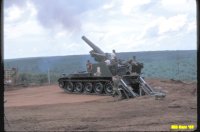| Flight #1 |
|
Quan Loi International Airport The 3rd Maintenance Company. Dian, assigned to the 610th Maintenance Battalion, Cu Chi, was tasked in the early spring of 1967 to supply a contact team for support to A Battery, 6/27 Artillery in Quan Loi. Five mechanics, an experienced NCO, and a young 2nd Lt. formed up in the next convoy northbound on Rt. 13. (Photo 1) The trip was uneventful to An Loc. (Photo 2) The team took the right turn, drove through the rubber and then came upon an airstrip with four SP guns on the left. (Photos 3 & Photo 4
|
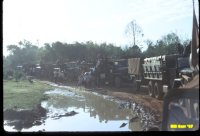 |
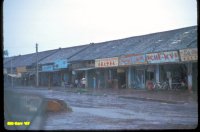 |
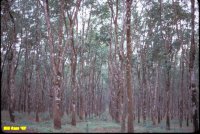 |
| (Photo 1) | (Photo 2) | Photo 3) |
A Battery's Quan Loi home (Photo 4)
A shop area was set up and the mission soon became clear. Not only was the normal automotive type of repair for vehicles operating in a red dust bowl or a red mud pool a part of our mission, the changing of tubes was job one. It was quickly learned that the effective safe total tube life could come at anytime of day or night. A change had to be accomplished safely and speedily. A true testament to the professionalism of the entire battery was the frequency of the call for a tube change.
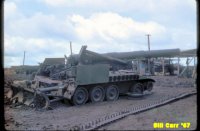 OJT worked its wonders and the team became fairly proficient in the trade. (See
“Changing a 175mm tube” on this site) Charlie also got to know that the battery
was there. One
night the contact team was awoken by incoming mortar rounds. This was a totally
different sound than the outgoing 8” and 175mm rounds which one could adapt to
for sleep purposes. The VC wanted to stop the nightly H&I fire, Turkey Shoots,
support missions to the area Special Forces bases, and general havoc those 4
guns brought to the enemy. Others can give the full story of how the battery
staved off being overrun that night. Let it be said that it was a long night and
the VC managed to severely damage an 8” gun.
OJT worked its wonders and the team became fairly proficient in the trade. (See
“Changing a 175mm tube” on this site) Charlie also got to know that the battery
was there. One
night the contact team was awoken by incoming mortar rounds. This was a totally
different sound than the outgoing 8” and 175mm rounds which one could adapt to
for sleep purposes. The VC wanted to stop the nightly H&I fire, Turkey Shoots,
support missions to the area Special Forces bases, and general havoc those 4
guns brought to the enemy. Others can give the full story of how the battery
staved off being overrun that night. Let it be said that it was a long night and
the VC managed to severely damage an 8” gun.
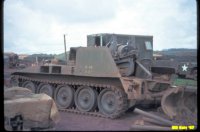 A
day or two passed, more perimeter support was received, the area was policed.
Visitors from artillery and maintenance higher Hq’s arrived. Stars and eagles
all over the place looking at the damaged gun. It was asked if we could repair
the gun.
Were
they just trying to be nice to us? They were politely (?) informed that with
all the parts, tools, repair manuals, and expertise, it might take six men
several months! Not a satisfactory answer. The entire base camp shortly found
out what stars and eagles could really accomplish when they wanted something
other than giving lower ranks condescending looks. They wanted four operational
guns in Quan Loi.
A
day or two passed, more perimeter support was received, the area was policed.
Visitors from artillery and maintenance higher Hq’s arrived. Stars and eagles
all over the place looking at the damaged gun. It was asked if we could repair
the gun.
Were
they just trying to be nice to us? They were politely (?) informed that with
all the parts, tools, repair manuals, and expertise, it might take six men
several months! Not a satisfactory answer. The entire base camp shortly found
out what stars and eagles could really accomplish when they wanted something
other than giving lower ranks condescending looks. They wanted four operational
guns in Quan Loi.
The road from the south had not seen a convoy for several weeks. There were no plans to dedicate resources to open the road. Everything; food, beer, mail, ammo, replacement tubes, POL, personnel, all came to Quan Loi via air. The C-130 and smaller aircraft could handle those items. A M-110 SP carriage was another matter. A C-141 was capable, but out of the question as the airstrip was considered unimproved as far as the large jet was concerned. That left the propeller driven C-124 Globemaster.
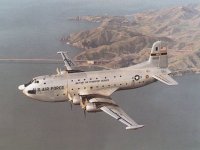
Within days, an Air Force
technical team arrived to measure every part of the strip. Borrowing a line from
a popular Guthrie song of day, “they left no part … injected or uninspected.” By
the end of the day the decision was a definite maybe. The length, width, and
firmness of the strip were marginal considering the total weight of the
aircraft. There were no replacement chassis in Vietnam. The closest one was in
a depot in Okinawa. The stars and eagles made it happen. We were advised there
would be a delivery in a couple of days. Quan Loi was going to have an
international flight.
A safety team arrived to set up communications with the aircraft for advice on
exact weather conditions at the time of touch down. The major concern was
stopping. Head wind, fuel load, temperature, all played a critical part of
safely bringing the aircraft to a halt. By mid-morning a large aircraft could be
seen and heard circling the strip to burn off fuel. The “come on in” was given
and many eyes and cameras focused on the end of the field.
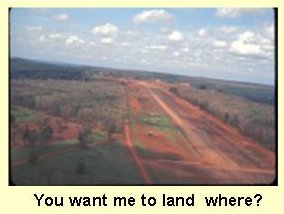
There was no taxi to a gate. The crew didn’t wait for the captain to turn off the seat belt sign. Their job was half complete; they were safely on the ground waiting to open the cargo doors. You can just about make out a smile of satisfaction on the crew member faces as they were getting their first look at our home. Without ever shutting down the engines, the loadmaster got the doors opened and started the track. Out it came.
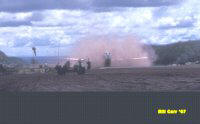
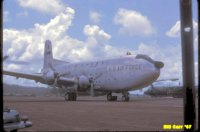
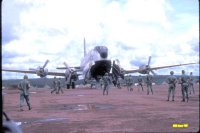
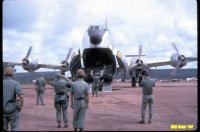
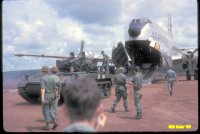
FIRE MISSION On target.

